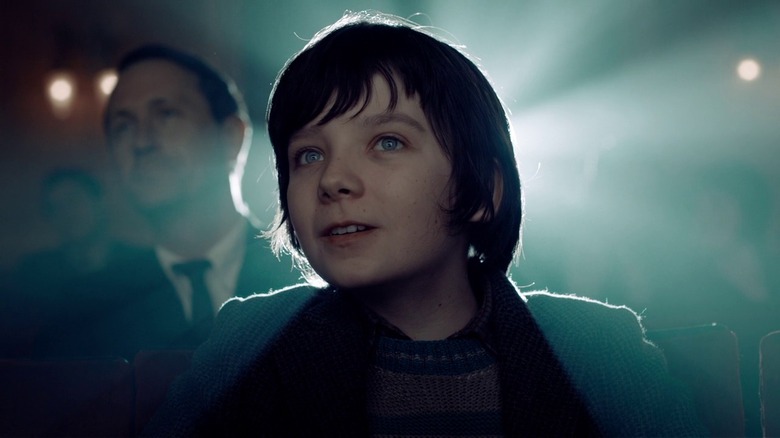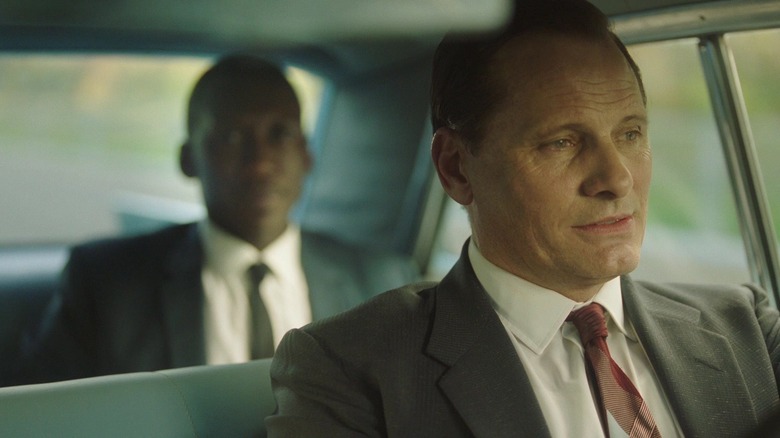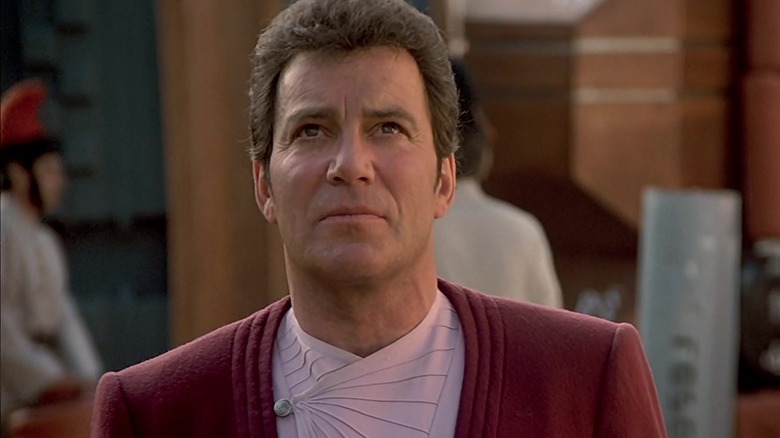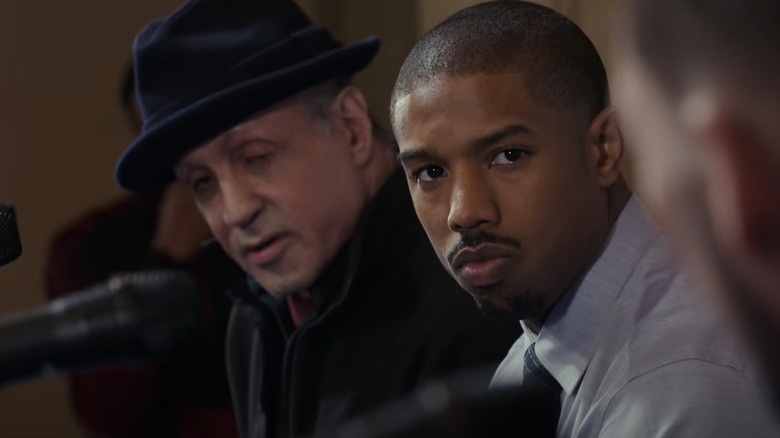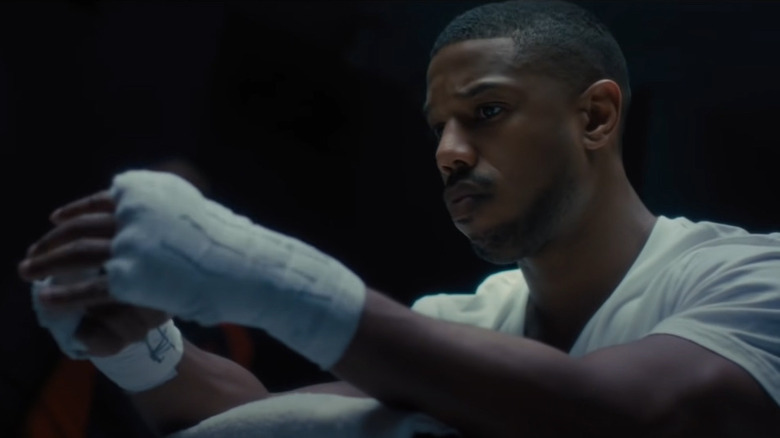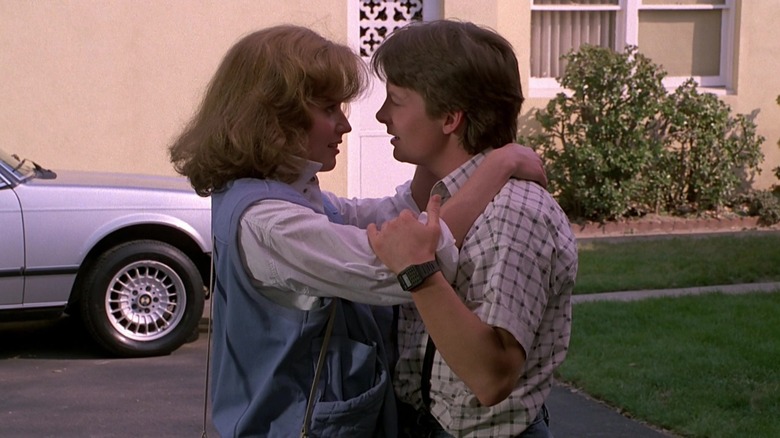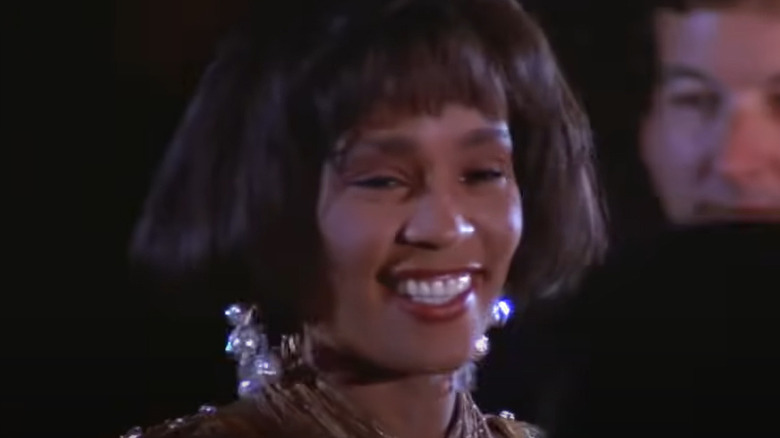Biggest Non-Disney Movies Ever Released At Thanksgiving
When it comes to the Thanksgiving box office, Disney is the undisputed ruler. The massive success of features like "Oliver and Company," "Beauty and the Beast," and "Aladdin" solidified this holiday weekend's lucrative reputation for the Mouse House. Disney has maintained a firm grip on November well into the 21st century, thanks to smash hits like "Frozen" and "Coco." They've even found success with live-action features, as evidenced by 1987's "Three Men and a Baby," which proved to be the highest-grossing movie of the year in North America.
Disney isn't the only studio that's earned major returns at the box office within this timeframe, however. Many different titles from various creators have proven to be just as enticing to Thanksgiving moviegoers as a perfectly cooked turkey. These productions vary in genre and style, ranging from sports films to adult-oriented comedies and everything in between. What unites them are their Turkey Day debuts, and their unquestionable success. These are the biggest non-Disney movies ever released at Thanksgiving.
Hugo
A flood of family-oriented movies opened in time for Thanksgiving 2011. A most unusual bird was among this kid-friendly flock: "Hugo," a new directorial effort from Martin Scorsese. Based on the book "The Invention of Hugo Cabret" by Brian Selznick, this film is bursting with fantasy elements and a deep love of cinema. The fact that it fits the bill as family entertainment, yet also comes from the director of titles like "The Departed" and "Taxi Driver," makes it an unusual concoction. Perhaps that's why it initially opened in just 1,277 locations, significantly below the 3,000+ theater counts other family titles in the marketplace earned.
Going with just 1,277 locations meant "Hugo" could grow its reach in North America as the weeks went on and award season nods piled up. This release strategy allowed "Hugo" to score $73.8 million in North America, after a meager $11.3 million debut. That was enough to make "Hugo" the seventh-biggest Scorsese movie in North America. It also far exceeded fellow November 2011 movies "Happy Feet Two" and "Arthur Christmas." However, those achievements weren't nearly good enough for a family movie that cost over $150 million to produce. In the crowded Thanksgiving landscape, "Hugo" got lost in the shuffle.
Penguins of Madagascar
While Disney hones in on specific times of year for their releases, DreamWorks tends to be more erratic. For 2014's "Penguins of Madagascar," the studio decided to go with a Turkey Day debut. A spin-off of the popular "Madagascar" movies, each of which exceeded $180 million at the domestic box office, it probably seemed like a sure thing.
"Penguins of Madagascar" proved to be way less financially successful, however, grossing just $83.3 million in North America. This total also put it behind several other 2014 animated titles in terms of domestic gross, including fellow DreamWorks release "Mr. Peabody & Sherman." Those scheming Penguins might be popular, but "Penguins of Madagascar" opened nearly a decade after the first "Madagascar" hit theaters. The novelty of these characters had apparently worn off — especially since "The Penguins of Madagascar," a Nickelodeon cartoon that debuted in 2009, likely satisfied most cravings for Penguin-centric escapades. With such a minuscule box office performance to its name, it's no surprise the "Madagascar" series went into hibernation.
Green Book
"Green Book" has become defined by its Academy Awards victories — specifically, its Best Picture win, which has proven to be controversial. In the years since that fateful Oscar night, the conversation surrounding this film has centered around everything from star Viggo Mortensen's dismissal of criticism (via The Independent) to broader troubles in the film industry it might represent (via The Washington Post). Between all these discussions, it can be easy to forget that "Green Book" was also a tidy moneymaker at the box office.
Of course, it didn't immediately seem that way. Outlets like Deadline labeled the film's first box office grosses as more tepid than promising. But in the weeks that followed its Thanksgiving 2018 debut, "Green Book" just kept motoring along. Managing to stick around in theaters through Christmas 2018 based on strong word-of-mouth and attention from award shows like the Golden Globes, "Green Book" was able to hit $85 million in North America. That's nearly four times its $23 million budget, which makes it one of the higher-grossing Best Picture winners of the 2010s. This financial success adds another fascinating detail to the ever-complicated discourse surrounding "Green Book."
Rise of the Guardians
2012's "Rise of the Guardians" became a landmark moment for DreamWorks Animation — unfortunately, in all the wrong ways. Though the studio hadn't exclusively released mega-blockbusters up to this point, its switch to computer animation meant that DreamWorks could be counted on to make reliably higher-grossing films. From June 2008 to June 2012, all of the studio's titles exceeded $145 million domestically. Four of the features released in that era even managed to soar past $195 million. "Rise of the Guardians," in contrast, brought in box office figures significantly below those high-water marks.
Debuting over Thanksgiving 2012, "Rise of the Guardians" amassed a mere $32.3 million in its first five days of theatrical release in North America. The film's connection to Christmas (thanks to Santa Claus being one of its main characters) helped it hold steady over the next month, legging out to a $103.4 million domestic haul. While that made it the first non-Disney animated film to exceed $100 million in North America after a Thanksgiving opening, "Rise of the Guardians" still made less than most other computer animated DreamWorks films up to that point. Given its $145 million budget, this fantasy adventure was a long ways away from profitability. Playing against its fellow Thanksgiving 2012 family film "Life of Pi" further cemented the financial shortcomings of "Rise of the Guardians."
Star Trek IV: The Voyage Home
The first six "Star Trek" movies, which focus exclusively on the cast of the original series, stuck dutifully to being released either the first weekend of June, or in December. There was, however, one exception: "Star Trek IV: The Voyage Home," one of the franchise's best installments, which opted for a Thanksgiving 1986 debut. Paramount Pictures brass decided to shift this title from December to November to give the studio's Christmas movie, "The Golden Child," more room (via The New York Times). Any time a franchise deviates from its normal release patterns, it's making a risky move. But this one ended up paying off big time.
Grossing $109.7 million domestically on a modest $24 million budget, this highly profitable production became the first installment in the "Star Trek" franchise to exceed $100 million in North America. Even better, it managed to hold on strong over the extended holidays: "The Voyage Home" experienced its second-largest single weekend gross in its fifth weekend of release. By the time all ticket sales had been beamed up, "The Voyage Home" emerged as the fifth-biggest movie of 1986, outpacing high profile titles like "Aliens" and "The Golden Child." Thanksgiving hasn't always been a go-to home for "Star Trek" movies, but the sizeable success of "The Voyage Home" suggests it should be.
Creed
Considering the success "Rocky" movies have had opening over Thanksgiving, it was clear where "Creed" had to land on the release calendar. However, opening over Thanksgiving 2015 was anything but a surefire way to drum up money. Debuting in this corridor meant "Creed" would be opening between "The Hunger Games: Mockingjay — Part 2" and "Star Wars: The Force Awakens." Could a smaller boxing drama manage to excel with so much competition for the hearts and minds of moviegoers?
Luckily for "Creed," the enduring appeal of the "Rocky" franchise won the day once more. "Creed" managed to knock out $42.6 million in its first five days of domestic play (via Deadline). One of few non-Disney titles to ever crack $30 million in its three-day Thanksgiving opening weekend, "Creed" continued to keep on chugging through the rest of 2015. By the end of its North American box office run, "Creed" managed to crack $109.7 million. That's a noticeable increase over the $70.2 million haul of the last entry in the franchise, 2006's "Rocky Balboa." "Creed" became yet another reminder that the "Rocky" series has a particular knack for producing Thanksgiving hits.
Creed II
When the original "Creed" hit theaters in November 2015, it was met with uncertainty over its box office prospects. When 2018's "Creed II" stepped into the box office ring three years later, however, all questions had been answered. Not only was the original movie a big hit, its lead performers, Michael B. Jordan and Tessa Thompson, had headlined Marvel blockbusters in the intervening years. The "Creed" franchise was now the titan instead of the underdog.
Given this increase in profile, it's no surprise "Creed II" was a knockout box office hit. In its first five days of release, the film shattered all expectations with a $55.8 million five-day domestic opening (via Forbes). These are the kind of debut figures usually reserved for Disney cartoons over this holiday frame, not sports dramas. But the success of the first "Creed," Jordan and Thompson's increased star power, and this film's connection to "Rocky IV" through Dolph Lundgren's return, got people to come out in droves. Though it wasn't quite as leggy as its predecessor, "Creed II" still exceeded the first film's North American haul by grossing a robust $115.7 million. It didn't just live up to its increased expectations — it blew past them.
Back to the Future Part II
Some of the titles on this list were sleeper hits that nobody expected big things from. Then there's "Back to the Future Part II," which arrived in theaters over Thanksgiving 1989, four years after the original "Back to the Future" became one of the biggest movies in history. There was no question this sequel would be a massive hit, given how deeply entrenched its predecessor had become in pop culture. The only question was just how big this blockbuster would prove to be.
Turns out, the answer is "very, very big". "Back to the Future Part II" accumulated $118.4 million domestically, the sixth biggest domestic haul of 1989 and the second biggest for a title released outside of that year's summer season. It's also roughly three times the movie's $40 million budget, making "Back to the Future Part II" plenty profitable, even before its sizeable international grosses. While this installment is the only entry in the "Back to the Future" saga to get a release outside of summer, going for a Thanksgiving debut was definitely a wise move. This is especially apparent when considering the fact that "Back to the Future Part II" set a record for Thanksgiving newcomer opening weekends it would hold for seven years. This box office glory truly proves the power of love — er, a Thanksgiving weekend opening.
Four Christmases
Post-"Wedding Crashers," Vince Vaughn was a hot box office item. Subsequent hits proved that the 2005 comedy was no financial fluke. Among these successes was 2008's "Four Christmases," which pairs Vaughn up with Reese Witherspoon. The duo travels across the country to visit their estranged parents, presenting plenty of opportunities for star-studded cameos and rib-tickling shenanigans.
With a Thanksgiving 2008 launch pad, "Four Christmases" was primed to appeal to moviegoers ready to move on from turkey to tinsel. Over its opening weekend, the film even managed to surpass the second weekend of "Twilight" and the debut weekend of Disney's "Bolt." Accumulating $46.7 million over its first five days of release, "Four Christmases" went on to make $120.1 million domestically. That sum made it the fourth-biggest movie Vaughn has ever appeared in as an actor, in terms of North America. As for Reese Witherspoon, this project turned out to be her second-biggest live-action film ever, domestically speaking, and one of only four live-action films she's appeared in to exceed the $100 million mark in North America. Though Vaugh's reign as a reliable box office draw wouldn't last forever, the "Wedding Crashers" afterglow, not to mention Reese Witherspoon's own ability to attract an audience, is apparent in the success of "Four Christmases."
The Bodyguard
"The Bodyguard" was not a critical darling. Much of its bad press stemmed from perceived shortcomings in the two leads' chemistry, as well as plot turns that register as forced, rather than sweepingly dramatic. These reviews didn't deter the general public, though. Audiences showed up in droves for "The Bodyguard" over the course of Thanksgiving 1992. The feature benefited greatly from its own star power: Whitney Houston was (and remains) a megawatt name, while Kevin Costner was hot off his Best Picture win for "Dances with Wolves" and the box office success of "Robin Hood: Prince of Thieves." All that glamour made "The Bodyguard" stand out in a Thanksgiving marketplace crowded with heavyweights like "Home Alone 2: Lost in New York" and "Aladdin."
Grossing $121.9 million domestically, "The Bodyguard" proved to be a significant hit on just a $25 million budget. Decades after its release, it's still one of only six movies Kevin Costner has ever appeared in that have exceeded $100 million in North America. It also proved successful enough to become the seventh-biggest movie of 1992 at the domestic box office. With all these achievements, negative reviews became a distant afterthought.
Rocky IV
By the time "Rocky IV" opened in theaters over Thanksgiving 1985, the "Rocky" franchise had been around for nearly a decade. The series had seen consistent success at the box office, but given its longevity, wondering if "Rocky IV" was going to become the installment to show the franchise's age was understandable. Instead, "Rocky IV" packed a financial wallop. For many decades, it was the highest-grossing non-Disney movie to be released over the Thanksgiving frame.
"Rocky IV" took off like a rocket with audiences, who proceeded to flock to the movie all through the rest of 1985. Topping the domestic box office for six straight weekends, "Rocky IV" was eventually able to crack $127.8 million in its North American run. That made it the biggest entry in the "Rocky" series up to that point, narrowly edging out the $125 million haul of "Rocky III." It was also one of just three movies to exceed $100 million domestically in 1985 (boy, is that a change of pace from the modern film landscape). Only "Back to the Future" and fellow Stallone vehicle "Rambo: First Blood Part II" out-grossed it among North American earners that year. Going for a fourth entry has seen some franchises hit box office lows. But, rather than tapping out, "Rocky IV" made the "Rocky" series stronger than ever.
Knives Out
You don't need to be a sleuth like Benoit Blanc to figure out why "Knives Out" became such a beloved hit. The film's marketing promised a star-studded and light-hearted affair that would appeal to moviegoers of all ages. Meanwhile, positive reviews from the film festival circuit brewed up extremely solid word-of-mouth months before the film embarked upon its general theatrical release. Moreover, the murder mystery wasn't a super prominent film genre when "Knives Out" premiered in 2019, making it stand out even further.
The financial success of "Knives Out" was immediately apparent when it started its North American box office run over Thanksgiving 2019. Shattering all pre-release expectations (via Deadline), this clever caper carved up a robust $41.7 million over its first five days of release. Now, some Thanksgiving newcomers fail to develop legs beyond that holiday frame and sink in the ensuing weeks. Not so for "Knives Out," which just kept on playing and playing, well into 2020. Once all tickets had been sold and its domestic run was finished, "Knives Out" had grossed a mammoth $165.3 million. That's roughly on par with the North American hauls of Craig's Bond films "Casino Royale" and "Quantum of Solace," despite "Knives Out" being an original property with significantly less spectacle to offer moviegoers.

